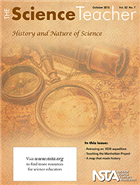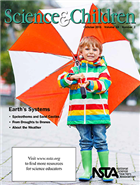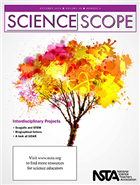Ideas from NSTA's October K–12 journals
By Mary Bigelow
Posted on 2015-10-18
Each of the K-12 journals this month includes DCIs, SEPs, and CCs, Oh My! Understanding the Three Dimensions of the NGSS with in-depth descriptions of what the Disciplinary Core Ideas, Science and Engineering Practices, and Cross-cutting concepts mean for science curriculum, instruction, and assessment. A must read!
The themes of the three K-12 Journals in October fit together nicely – the History and Nature of Science lends itself to interdisciplinary studies, and studying the earth provides a context for these studies.
 The Science Teacher: History and Nature of Science
The Science Teacher: History and Nature of Science
The featured articles focus on how historical events and discoveries connect with scientific knowledge and how this knowledge changes with new events and discoveries. See this month’s Science Scope for more lessons on the interdisciplinary Nature of Science.
- Teaching the Manhattan Project describes an interdisciplinary unit that examines the relationship between discoveries in science and the development of nuclear weapons.
- William Smith’s Mapping Milestone – Last summer, I had the opportunity to see Smith’s geologic map of Great Britain at the Geological Society in London. The 100-year old map is amazing in its size, detail, and importance. This article focuses on how “Interactive Historical Vignettes” (including one based on this map) can be used to help students understand the nature of science.
- Chemical Solitaire – Students use element cards to explore patterns among elements and how to organize them as new elements are added to the mix.
- A Cool Controversy – Glaciers are used as a historical context for learning current concepts. Students make and use models of glaciers and photos of student work are included.
- Are We Alone in the Universe? – Recent discoveries on Mars have raised interesting possibilities. This article describes how the SOURCES framework can be used to integrate primary sources into science investigations. The article includes links to some of these sources.
- Idea Bank: Exploring the History of Science With Movies Liven up student learning about scientists and their work with video segments. The article includes sources for brief, focused video segments as well as suggestions for using them in the classroom.
- Career of the Month: Science and Technology Librarian The Smithsonian recently had an article on the “death” of the card catalog. Find out what a 21st century science librarian does and why their jobs are important.
- Safer Science: Safety in the Field Be sure to read NSTA’s Safety Advisory Board’s white paper on Field Trip Safety, described in and linked from this article.
Here are some SciLinks with content information and suggestions for additional activities and investigations related to this month’s featured articles: Glaciers, Ice Ages, Life on Other Planets, Nuclear Reactions, Our Universe, Periodic Table.
Continue for Science and Children and Science Scope.
 Science and Children: Earth’s Systems
Science and Children: Earth’s Systems
This issue focuses on Systems, with examples from earth science, specifically related to climate and weather. Although many elementary students study the weather, understanding how weather and climate are related (and changing) is important for students. As the editor notes, “The core ideas should begin with place-based weather concepts and then expand to global climates.”
- Speleothems and Sand Castles – Students can study the formation of stalagmites and stalactities in the classroom.
- Using Models Scientifically – Kick up the study of the water cycle to incorporate more about using models.
- From Droughts to Drones – Students study local situations using current technology.
- Animal Detectives – How do animals, specifically wolves, relate to and interact with their habitat?
- NGSS in Action – Studying soil provides a context for English Language Learners.
- Teaching Through Trade Books: Wonderful Water – The two lessons here focus on the role of water in earth processes.
- The Early Years: About the Weather – Our youngest students can learn to document local weather and look for patterns.
- Formative Assessment Probes: Wet Jeans – What do students understand (or misunderstand) about the water cycle, including evaporation and condensation.
- Engineering Encounters:
Nature as Inspiration – How can a study of plant structures lead to ideas for collecting and storing water?
Here are some SciLinks with content information and suggestions for additional activities and investigations related to this month’s featured articles: Caverns, Drought, Groundwater, Landforms, Soil, Weather, Water Conservation, Water Cycle, Wolves.
Science Scope: Interdisciplinary Projects
“Viewing similar content from multiple perspectives can enhance learning, produce a greater depth of understanding, and foster creativity and insight,” according to the editor. Many of these articles also address the Nature of Science, the theme of The Science Teacher.
- Using a STEM-Based Approach to Make Recycling Metallic Elements Relevant has suggestions for an interdisciplinary investigation into properties of metals and the costs and logistics of recycling them.
- See Less Sea-Less Seagulls: Planning for an Interdisciplinary STEM Unit describes an extended interdisciplinary project and the planning and preparation it required.
- Connecting the Dots: Lasers Link Students to Their 3-D World has suggestions for building and using a 3-D mapping instrument.
- Shrimp and Black Gill: Studying the Effect of Apostome Ciliates includes resources for a role-playing game that simulates ecological relationships and interactions.
- Using Biographical Letters to Draw on the Nature of Science shows how writing and science can be integrated into a study of the history and nature of science with classroom examples.
- Tried and True: Using Observations of Fossils to Reconstruct Ancient Environments – Not all science investigations are experiments. This article shows how students can conduct observations of fossils and derive conclusions from them.
- Teacher’s Toolkit: Bridging the Three Dimensions of the NGSS Using the Nature of Science describes how to adapt a lesson to incorporate the nature of science. The sample lesson is one on exploring the features of the ocean floor.
Here are some SciLinks with content information and suggestions for additional activities and investigations related to this month’s featured articles: Ciliophora, Crustaceans, Fossil Record, Fossils, Landforms, Lasers, Ocean Floor, Metals, Recycling, Scientists’ Biographies, Sonar.
Disclaimer: The views expressed in this blog post are those of the author(s) and do not necessarily reflect the official position of the National Science Teaching Association (NSTA).



